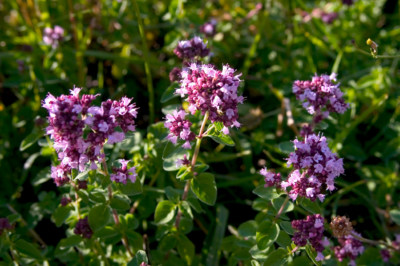
The flowers: edible and very aromatic
Oregano develops densely crowded pseudo panicles with inflorescences at the tips of the shoots, from which the small lip flowers develop from early July to late September. The white, pale pink or purple flowers are very fragrant and serve as a food source for numerous insects. You can carefully pluck the delicate flowers from the plant and use them directly or dry or preserve them together with the oregano branches.
From the center of the inflorescence protrude clearly visible four stamens. The short upper lip of the flower is fringed at the tip. The lower lip is three-lobed. After flowering, when dry, the fruit disintegrates into nutlets (clauses) about one millimeter in size, which are dispersed by the wind in the surrounding area.
Use fresh oregano flowers as a decorative and aromatic ingredient in salads or as edible food decoration. The aroma of the flowers goes very well with tomato or cucumber salad. They also look extremely attractive in herb butter or cottage cheese and add an interesting touch to dishes.
Preserving the flowers
If you would like to preserve oregano after harvest, you should tie it together with the flower umbels into small bunches and dry them hanging upside down. Reel the fully dried flowers and leaves from the branches and store the seasoning herb in tight-fitting jars in a dark place.
You can also dry the flowers individually and store them separately from the leaves. Sprinkle the dried flowers on a plate and gently wet them. Immediately they will unfold their delicate color and characteristic aroma.
Tips & Tricks
Ice cubes with oregano flowers add a special touch to summer cocktails. Put some of the small umbels in the ice cube maker and fill it up with water.

